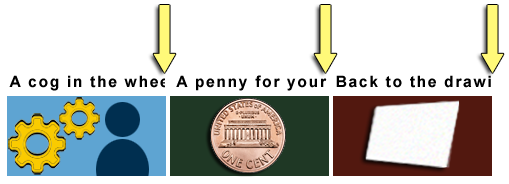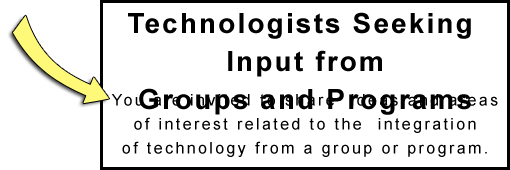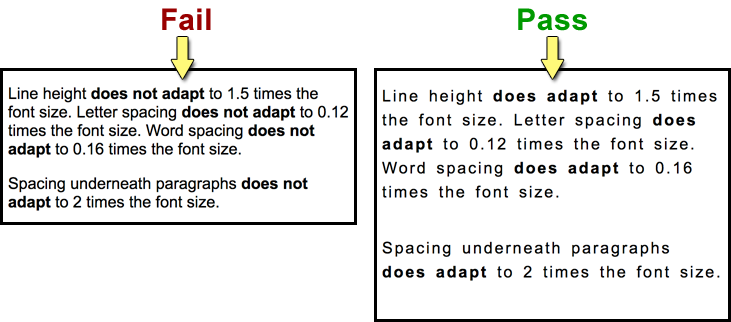Understanding Adapting Text
Intent
The intent of this Success Criterion is to help ensure that people with disabilities who override spacing or font family (also called font face or typeface) can read text. It allows for a spacing buffer. Increased spacing between lines, words, and letters has benefits for people who override author settings via user stylesheet, bookmarklet, extension, or application. They may need to change font family (e.g. to a wider one) than the author has set to effectively read text. They may increase spacing between lines, words, and letters to effectively read text. Line spacing also helps with tracking. Tracking is following along lines of text, including getting from the end of one line to the beginning of the next line.
This SC does not dictate that authors must set all their content to the specified metrics. Rather, it specifies that an author's content has the ability to be set to those metrics without the loss of content or functionality. The author requirement is to not to interfere with a user's ability to override the author settings.
If the technologies being used are capable of overriding text to the Success Criterion's metrics, then this SC is applicable. For instance Cascading Style Sheet/HTML technologies are quite able to allow for the specified spacing metrics. Plugin technologies would need to have a built in ability to modify styles to the specified metrics. Currently, this SC can not be reliably tested in PDF user agents.
For this Success Criterion the canvas implementation of text is considered to be images of text. @@ Suggestion from @steverep to move this sentence to the definition of images of text as it affects additional SCs. Leaving it in until when/if consensus is reached and definition is updated.
Benefits
- People with low vision who require increased space between lines, words, and letters are able to read text.
- People with dyslexia may increase space between lines, words, and letters to increase reading speed.
Examples
- Text is not cut off when increased spacing is applied to text.
- Text does not wrap out of the containing box or cause text to overlap when increased spacing is applied to text.
- Text is not absolutely fixed.
The following images show examples of failures when authors do not take into consideration that users may override spacing to the metrics specified in this Success Criterion.
Example 1: Text Cut Off
The bottom portion of the words "Your Needs" is cut off in a heading making that text unreadable. It should read "We Provide a Mobile Application Service to Meet Your Needs."
Figure 1: Text cut off vertically is a failure.
In Figure 2 the last portion of text is cut off in 3 side-by-side headings. The 1st heading should read "A cog in the wheel." But it reads "A cog in the whe". Only half of the second "e" is visible and the letter "l" is completely missing. The 2nd heading should read "A penny for your thoughts". But it reads "A penny for your". The 3rd should read "Back to the drawing board." But it reads "Back to the drawi".
Figure 2: Text cut off horizontally is a failure.
Example 2: Text Overlap
In Figure 3 the last 3 words "Groups and Programs" of the heading "Technologists Seeking Input from Groups and Programs" overlap the following sentence. That sentence should read, "You are invited to share ideas and areas of interest related to the integration of technology from a group or program perspective." But the words "You are invited to share ideas" are obscured and unreadable.
Figure 3: Overlapping text is a failure.
Example 3: Fixed Text
Text fails the SC when it is fixed and not able to be overridden to the Success Criterion's metrics.
Text that allows for overriding to the metrics passes. Line height must be able to adapt to 1.5 times the font size. Letter spacing must be able to adapt to 0.12 times the font size. Word spacing must be able to adapt to 0.16 times the font size. Spacing underneath paragraphs must be able to adapt to 2 times the font size.
Figure 4: Absolutely fixed text is a failure. Adaptable text passes.
Resources
- Allan, Kirkpatrick, Lawton Henry, Editors. (2017). Accessibility Requirements for People with Low Vision (3.4 Spacing for Reading). World Wide Web Consortium.
- Chung, Susana T. L. (2012). Dependence of Reading Speed on Letter Spacing in Central Vision Loss. Optom Vis Sci.
- Chung, Susana T. L. (2002). The Effect of Letter Spacing on Reading Speed in Central and Peripheral Vision (PDF). IOVS ARVO Journals.
- Mcleish, Eve. (2007). A study of the effect of letter spacing on the reading speed of young readers with low vision (PDF). The British Journal of Visual Impairment 25.2: 133-43.
- Rello, L., & Baeza-Yates, R. A. (2017). How to present more readable text for people with dyslexia. Universal Access in the Information Society, 16(1), 29-49.
- Sjoblom, A.M., Eaton, E. and Stagg, S.D., (2016). The effects of letter spacing and coloured overlays on reading speed and accuracy in adult dyslexia. British Journal of Educational Psychology, 86(4), pp. 630-639.)
- Zorzi, Marco et, al. (2012). Extra-large letter spacing improves reading in dyslexia. Proceedings of the National Academy of Sciences.
Techniques
Sufficient
Advisory
- C8: Using CSS letter-spacing to control spacing within a word
- C21: Specifying line spacing in CSS
- C28: Specifying the size of text containers using em units
Failure
- Failure of Success Criterion 1.4.13 due to not allowing for spacing override. (Future technique)



